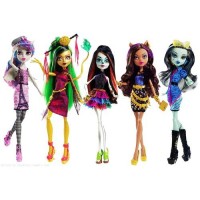I don’t hang out in the toy aisle at Target often, mostly because I hate seeing blatant gender division (the pink “girls’ ” Legos are shelved with Hello Kitty and Barbie, and all the other Legos get their own shelving unit on the clearly labeled “boys'” side, for instance, and that makes me cranky). But I was there anyway, and my six year old daughter had to get birthday presents for her friends… And that’s when I saw this.
I have written about the reservations I have about Monster High in the past, but I’ve also noted that there isn’t much else out there for monster-loving girls. Monster High is a multimedia franchise with not just dolls but webisodes, books, and much more– a true multimedia franchise– and it is a franchise that continues to grow. It seems like a possible way to catch the interest of girls in classic monsters, both movies and books. But then I walked in to the toy aisle, and there was this: the “Create-A-Monster” set.
I had read that the dolls were so skinny that you had to take the hands off to put on the clothes, but this goes way beyond that. This “Create-A-Monster” set completely disassembles two of the dolls into their assorted parts with various fashion accessories included. On a feminist level, I can’t see how a toymaker could possibly have managed to depict the extreme of objectification you can see here. The parts are interchangeable, which I guess would allow for some creativity, but kids playing “create-a-monster’ here are working with a limited number of options, with their goal to create the dolls as they appear on the box. There are other “Create-A-Monster” sets, so I suppose that with an unlimited supply of money and imagination, a kid could purchase many sets, toss the pieces together in a box, and build all kinds of crazy monsters, as this little Victoria Frankenstein did (start the video at 3:20) kind of like my husband does with various specialty sets of Legos. That’s gruesome and disturbing, but in kind of a cool way. But is that how the girls who play with Monster High actually used these dolls in their imaginary play?
Now, because both my husband and son are kaiju lovers, I have seen many Youtube videos done by kaiju loving enthusiasts where the creators actually film movie battles (usually using very stop motion animation of various quality, such as this one) using their existing action figures (don’t feel that you have to watch the whole thing). Now, granted, kaiju have kind of a limited palette of activity available to them if you stick with the original creators’ narratives, since most of what they do on screen is battle other kaiju and destroy things. You can’t dress them up easily, the parts aren’t interchangeable, and they’re more likely to step on a shopping mall than shop at one. That hasn’t stopped my kids from making and acting out stories about Mommy Godzilla and Baby Godzilla going to haunted houses, amusement parks, and movie theaters, and solving mysteries with Scooby Doo and Geronimo Stilton. That’s all kind of unexpected. Kids can do what they want with the toy and the narrative that goes along with it once it’s in their hands. What kind of play do the Monster High dolls inspire, though? I saw review videos, acting out of traditional high school drama, and other rather mundane things that come along with owning a collectible fashion doll. NPR called the dolls “goth Barbie”. I object to their characterization as “goth” but it does look like in most ways they are being played with much in the same way as Barbie and other fashion dolls are. The Monster High dolls, then, are domesticating monsters rather than inspiring creative play that provides an opportunity to take an existing and tired narrative and remake it in new and exciting ways. Although there are always a few who will take what you give them and run with it. As this music video for Ke$ha’s song “Cannibal” shows, there are creative ways to use those extra body parts.
Monster High appears to be subverting the “normal” fashion doll narrative, but it’s only, for the most part appearance. But that can be reclaimed! Rather than letting corporate media and marketing determine how the girls you know play with the dolls, show the alternate narrative that comes alive when girl monsters come into their own. Children’s and school librarians, check over your library collection and see what you can find. The girls may be hard to find, but I guarantee they’re out there.
 So, one of the things that we talk about at MonsterLibrarian is the value of using media tie-ins and cross-platform media to get people involved in reading horror fiction. Given the way our world is evolving today, the natural targets for marketers are kids. I watch kids who do a great job integrating existing media characters and stories into completely different scenarios (the Monster Kid’s many stories about the classic mystery solving team of Detective Baby Godzilla and Scooby Doo come to mind) but, frankly, Godzilla and Scooby Doo are small potatoes when it comes to marketing to kids today.
So, one of the things that we talk about at MonsterLibrarian is the value of using media tie-ins and cross-platform media to get people involved in reading horror fiction. Given the way our world is evolving today, the natural targets for marketers are kids. I watch kids who do a great job integrating existing media characters and stories into completely different scenarios (the Monster Kid’s many stories about the classic mystery solving team of Detective Baby Godzilla and Scooby Doo come to mind) but, frankly, Godzilla and Scooby Doo are small potatoes when it comes to marketing to kids today.



Follow Us!